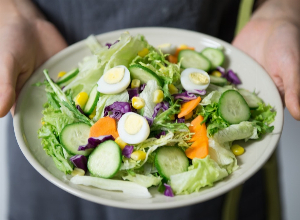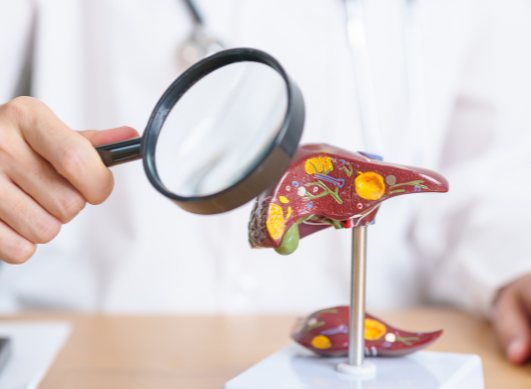Maintaining a healthy diet when living with Non-Alcoholic Steatohepatitis (NASH)
Published Dec 26, 2022 • By Rahul Roy
Non-Alcoholic Steatohepatitis (NASH) is a medical condition that causes damage and inflammation to the liver. While NASH development is not linked to alcohol consumption, lifestyle risk factors such as dietary choices and physical activity can help manage symptoms.
Who is at risk to develop NASH? How can food choices help manage NASH symptoms?
Discover in this article!

NASH is a type of liver disease, where excess fat accumulation in the liver leads to inflammation and scarring. This can prevent the liver from doing its primary and vital jobs, such as producing bile , storing vitamins, glycogen, or minerals, and metabolising fats, proteins and carbohydrates. When liver metabolism does not function as planned, it can lead to an excessive storage of fat within its cells, which can sometimes lead to inflammation and even the loss of functional liver tissue.
Who is at risk for NASH?
It is difficult to pinpoint the exact reason for the onset of NASH as fat accumulates in the liver for some people and not for others. The reasons why some fatty livers develop inflammation and scarring while others don’t are not fully understood by researcher yet. Overall, the main risk factors for NASH seem to be:
- Being obese or overweight
- Having high blood levels of cholesterol
- Living with type 2 diabetes, metabolic syndrome, or insulin resistance
- Smoking
- Living with sleep apnea
Fortunately, most of these risk factors can be prevented through lifestyle choices, which is why changes in diet and physical activity levels are often the first recommendations provided to NASH patients.
What are the signs and stages of NASH?
NASH is a progressive disease that gets better or worse over time depending on the lifestyle of the individual. If left untreated for a long period of time, it can be quite dangerous. The severity of the damage is defined in terms of stages-
Stage 1 : The liver will function as normal in this stage but the fat accumulated would have exceeded 5%, a phenomenon called steatosis., Steatosis can lead to low-grade inflammation and a possible reduction in the efficiency of liver functions. At this stage NASH is still Iconsidered as mild and can often be reversed to some extent through lifestyle changes.
Stage 2 : Along with the negative effects of the first stage, scarring or fibrosis begin to appear. Scarring refers to an unnaturally large amount of scar tissue in the liver, which is due to the liver trying to repair itself. The liver deteriorates towards its failure and is at a moderate severity.
Stage 3 : The liver reaches its most deteriorated condition i.e. cirrhosis. This is the most severe of all stages which requires a liver transplant in the majority of cases.
Since NASH is a disease whose symptoms are not easily visible, and generally people who have the disease feel fine, its diagnosis can be very tricky. The progressive nature of the disease means that the individuals tend to feel the symptoms only when the damage to the liver has worsened. However, here are some signs that may alert you:
- Pain and discomfort close to the abdomen
- Fatigue and tiredness
- A swollen belly
- Bruises and easily bleeding
- Visible and enlarged blood vessels beneath the surface of the skin
- Behavioral changes and slurry speech
- Yellowing of the skin and eyes – jaundice
Lifestyle changes can better help manage the health of the the liver and the food consumed plays an important part in that change.
What food can help the liver?
Vegetables
Regular consumption of vegetables provides the body bountiful sources of nutrients and vitamins. It is recommended that adults eat around 2-4 cups of vegetables each day. Green leafy vegetables especially may help maintain low levels of fat storage in the liver.
Fruits
Fruits are a great source of vitamins and nutrients and can be a suitable dessert after a meal. As some fruits contain high-levels of sucrose and fructose which can contribute to liver fat buildup, it is best to favour low-sugar fruits such as berries, citrus fruits, kiwi, or watermelon.
Whole grains
Whole grains provide a good protein and fiber punch that can keep your stomach full for longer. Grains like quinoa, barley, brown rice and farro are viable whole grains loaded in fibers too!
Nuts
Not only are they a great source of protein, but a diet rich in nuts has been suggested to reduce inflammation thanks to their omega-3 fat content. Nuts may also help reduce insulin resistance and improve gut health. Walnuts are a great option which may help reduce the fat in the liver as per a 2021 study.
Oatmeal
Fiber rich oatmeal has been suggested to lower blood cholesterol, triglycerides, and sugar levels, which are often higher in NASH patients. Oats may also help boost our immunity system, which is always a plus!
Fish and Lean Poultry
Fatty fish have high omega- 3 fatty acids that help reduce liver fat and lower triglyceride levels. On top of being great protein sources, fatty fish (e.g., salmons, sardines, tuna) and lean poultry (e.g., chicken, turkey) can help minimize inflammation too.
Beans
Beans such as chickpeas, lentils and soybeans contain gut health- improving starches that help lower blood glucose and may even lower triglycerides in some individuals. In addition to being nutrient dense, beans have shown a lot of promise in reducing visceral fat buildup in the liver.
What foods to avoid for the liver?
Alcohol
Alcohol consumption even in modest quantities may lead to more disease progression and stall NASH regression. The liver tries to break down the consumed alcohol, creating substances that are more harmful than alcohol, and regular consumption may accelerate the development of liver cirrhosis.
Added sugar
High sugar foods are a significant source of calories. Food products like ice cream, candy, chocolates, donuts etc. contain fructose that needs to be broken down by the liver. This may add to the liver burden already experienced by NASH patients. High-sugar foods may also contribute to fat accumulation in the liver and increased resistance to insulin.
Fried Fatty Foods high in salt
Fried fatty foods such as chicken wings, french fries and churro, have a considerable amount of saturated fat that may increase the fat content in the liver and contribute to the risk of developing heart disease. As high-saturated fat foods also increase the calorie intake by a large margin, they should provide less than 10% of the total energy intakes in adults, as per worldwide nutritional recommendations
Red Meat
Beef, pork and deli meats are high in saturated fat and are more difficult to break down in the body as opposed to fish and lean meats. A diet rich in those may increase the risk for fat accumulation in the liver as well as increasing insulin resistance.
White flour products
Processed carbohydrates such as white bread, pasta and white rice consumed in large amount may contribute to higher blood pressure. As they generally contain low amounts of fiber, it can be helpful to swap for wholegrain alternatives (e.g., wholewheat pasta and rice, brown bread, etc.) for NASH management.
Processed drinks
The sugar in these products is difficult to break down for the liver. The high fructose in soft drinks like Coca Cola, Pepsi, Fanta etc can hinder optimum liver functioning especially if consumed on a regular basis and in large amounts.
In addition to a balanced diet, adding exercise to your routine and aiming for an active lifestyle is an important consideration to manage NASH. . Overall, consuming healthy foods and exercising are complementary. Check in with your doctor to find out what diet suits you best along with the physical activities that can be undertaken to help the health of the liver. It is important to get plenty of sleep too!
So, don’t be rash with your diet, but instead make NASH quiet!
Did you like this article?
Click on "Like" or share your feelings and questions with the community in the comments below!
Take care of yourself!
Effect of alcohol consumption on nonalcoholic fatty liver disease - PMC (nih.gov)
Nonalcoholic fatty liver disease - Symptoms and causes - Mayo Clinic (mayoclinic.com)
NASH Symptoms - American Liver Foundation (liverfoundation.org)
Fatty Liver Diet: What Foods to Eat and What Foods to Avoid (healthline.com)
Eating, Diet, & Nutrition for NAFLD & NASH | NIDDK (nih.gov)
Nonalcoholic Fatty Liver Disease (NAFLD) & NASH | NIDDK (nih.gov)
Can You Eat Fruit with Nonalcoholic Fatty Liver Disease (NAFLD)? - Clean Eating (cleaneatingmag.com)
NASH friendly diet: What to know (medicalnewstoday.com)

 Facebook
Facebook Twitter
Twitter




